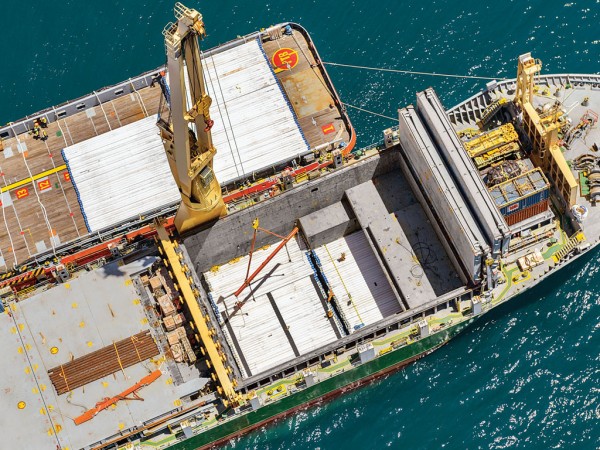It’s best for different coverages to be included in a single policy
The expanding demand for infrastructure enhancements in developing countries and elsewhere around the globe has allowed project cargo volumes to grow in recent years. Power stations, water filtration plants, communications systems, power grids, and construction equipment are some of the projects being shipped, while an increasing reliance on alternative energy sources has allowed wind and solar energy installations to emerge as major components of the global project cargo picture. China’s Belt and Road initiative also represents opportunities for the transfer of large-scale projects.

Project cargo policy coverages usually includes physical loss and damage and may also include consequential loss, such as delay in start-up (DSU) costs. DSU coverage provides indemnity for loss of anticipated profits, costs to avoid or mitigate a delay, debt servicing costs, and/or the increased cost of working.
From an underwriting standpoint, it is best to have both coverages included in a single policy, according to Erika Schoch, the head of marine reinsurance for Latin America at Swiss Re. “The value of any one item or part has little bearing on its significance to loss of profit,” she explained. The material loss underwriter “receives premium based on the value and the claim is paid relative to that value.” For the DSU underwriter, “loss or damage to low-value items which are vital to a contract might result in an entire plant being inoperable.”
The very nature of project cargo represents unique risks that must be confronted at the outset, during the planning stages. “Project cargo usually consists of large, heavy items, often having high centers of gravity,” said John Potter, head of marine and aviation at Antares Underwriting. “They are prone to toppling in transit and during handling.”
Project cargo also includes smaller pieces of equipment, such as computers, which may be critical to the operation. “Weather episodes can knock out a small-sized piece of equipment,” noted Potter. “The lesson is that the criticality of any one item for a project is a significant factor that the underwriter must bear in mind when assessing the risk.”
Some risks, such as theft, are lower for project cargo than for ordinary cargo but they are higher during lifting, handling, and general movement, noted Potter. Project Cargo is inherently unstable in transit and the greater claims costs, include “the extra charges involved in establishing whether the cargo has hidden damage, following any impact during transit or in handling.”
There is a significant threat to project cargo from heavy seas, especially when components are carried on deck. Another risk to project loads occurs during road transit, in the adverse camber of the roadway. The sloping of a road from its center to its sides could cause a large load to topple over, noted Potter, “resulting in substantial and expensive repairs, assuming it is not damaged beyond repair.” “If the item in question is critical to the project,” Potter added, “its loss may cause a delay in its completion.”
Collaboration
AGCS’s announcement of an expanded project cargo offering was formed by a partnership between its marine and engineering divisions. This collaboration allows AGCS to provide end-to-end coverage for companies managing unique and complicated risks, ultimately delivering a more comprehensive and fluid transaction under a single policy.
Underwritten by AGCS Marine, the policy is designed to manage risks of exposures such as shipment of equipment and machinery to construction sites; loss or damage of components in transit; DSU loss of income stemming from late or non-arrival of components; and construction all-risk insurance provided by engineering.
“Having a single policy cover both marine and engineering risks provides tremendous benefits such as enhanced risk management and expedited policy issuance and claims resolution,” said Kevin Wolfe, global head for project cargo at AGCS. “We now provide a single point of contact for clients and brokers, which makes it easier to identify whether a loss occurred in transit or during a construction phase. All underwriters and loss adjusters are with one company.”
Combining different risks, such as material loss and consequential loss, into a single policy is advantageous to both underwriters and insureds, noted Schoch. “Preferably they will be written as two sections of the same policy with the loss of profit claim triggered by a loss under the material damage cargo section,” she said. “That way, any condition or warranty imposed by underwriters on the cargo policy will similarly affect the advance loss of profit coverage.”
The alternative, writing two separate policies, one for material damage and the other for economic loss, would cause complications for all concerned. “The insured would have to submit claims separately to two sets of insurers who may not adopt identical positions,” Schoch explained. “With the same underwriters, the claim will be dealt with by one claims department in conjunction with the underwriter who assessed and wrote the risk. An overall view would be adopted minimizing the loss to both insurers.”
Presumably, the efficiencies occasioned by combining risks into a single policy should allow insurers to give their customers a break on the premiums. Still, project insurance will remain more expensive than other cargo policies.
“Project cargo produces very expensive losses,” said Potter, “so maximum premium income must be generated.”





